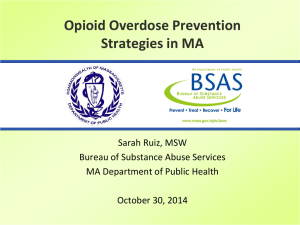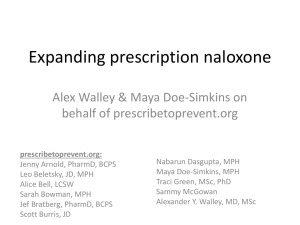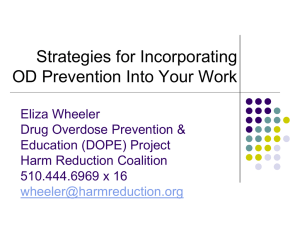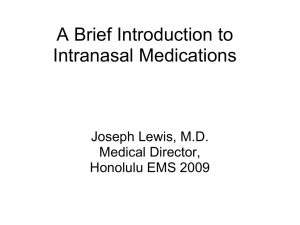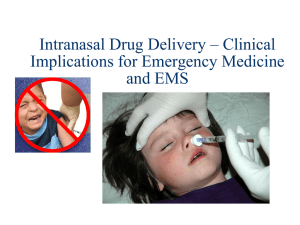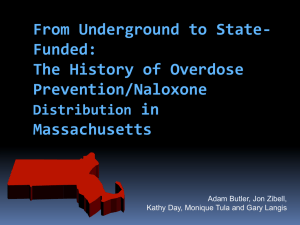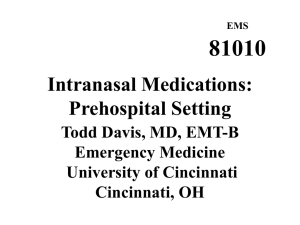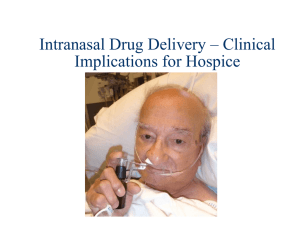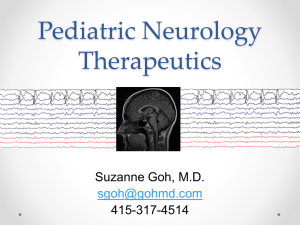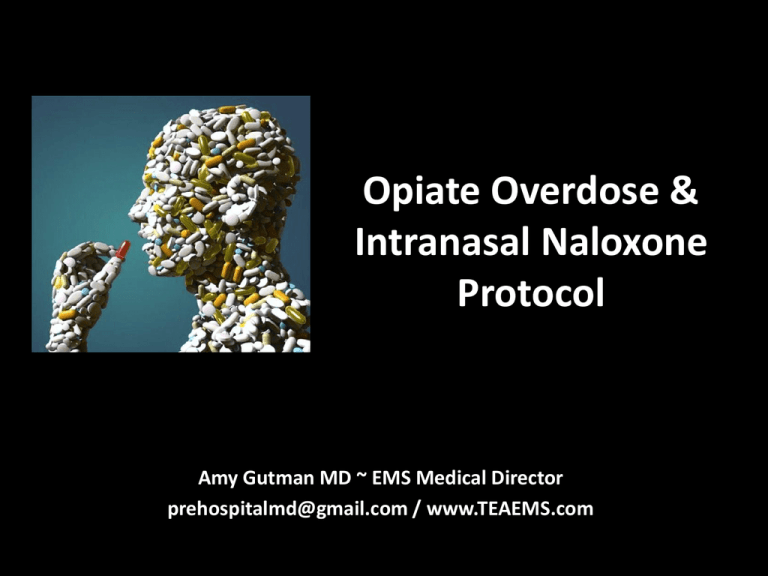
Opiate Overdose &
Intranasal Naloxone
Protocol
Amy Gutman MD ~ EMS Medical Director
prehospitalmd@gmail.com / www.TEAEMS.com
OBJECTIVES
• Review opiate pharmacology
• Review Naloxone / Narcan pharmacology
• Review needlestick injuries
• Review intranasal route advantages &
pathophysiology
Fail!
OPIOIDS / OPIATES
•
Among oldest known drugs (i.e. poppy flowers)
•
Analgesic effects of medications that stimulate brains’ “mu-opiod receptors”
decreasing pain perception & increasing pain tolerance
•
Therapeutic usage of opiods are for pain & cough suppression
•
Side effects are potentially lethal, including sedation, hypotension, histamine
reaction, respiratory depression, & euphoria (usually assoc with poor judgment)
•
Dependence develops with ongoing administration, leading to a withdrawal
syndrome with abrupt discontinuation (“Dope Sick”)
– N/V, tremor, seizure, tachycardia, HTN, diaphoresis, agitation, anxiety
– Opioid-induced hyperalgesia syndrome is paradoxically worsening pain as a result of
rapidly escalating dosage (often due to dependence)
MORE OPIOID OD DEATHS THAN MVC
DEATHS IN MA*
1200
Deaths per year
1000
Poisoning Deaths vs. Motor Vehicle-Related Injury Deaths,
MA Residents (1997-2008)
800
600
400
200
0
1997 1998 1999 2000 2001 2002 2003 2004 2005 2006 2007 2008
All Poisoning Deaths
*Registry of Vital Records and Statistics, MA DPH
Motor Vehicle-Related Injury Deaths
NEEDLESTICK INJURIES
•
•
CDC estimates >600,000 annual injuries involving contaminated sharps
–
–
–
–
High risk patients & high risk environments
AMS / combative
Scene control issues
Moving ambulance
OSHA’s Needlestick Safety and Prevention Act (2001) & Occupational Exposure &
Bloodborne Pathogens Standard (1991)
– “to reduce or eliminate hazards of occupational exposure, an employer must
implement an exposure control plan…The plan must describe how an employer will
use a combination of engineering & work practice controls. Engineering controls are
the primary means & include use of safer medical devices”
– “Employees responsible for direct patient care must have input into employer
decisions about WHICH engineering controls to adopt”
•
Intranasal systems meet OSHA recommendations to improve occupational
exposures by reducing Level III bloodborne exposures (HIV, hepatitis) by
decreasing needlestick injuries
IN DELIVERY ADVANTAGES
•
Simple, rapid, convenient
•
Nose is easy access point
•
Minimal training required
•
Painless
•
Eliminates needlestick risk
•
Compared to oral medications:
– Faster bloodstream delivery
– Higher blood levels
– No destruction by stomach acid &
intestinal enzymes
– No destruction by hepatic 1ST pass
metabolism
•
Compared to IV medications:
– Comparable blood levels
– Higher brain levels if well absorbed
across nasal mucosa
Naloxone should be made more widely
available to trained laypersons in an effort to
reduce deaths due to opioid overdose
IN EFFECTIVENESS
•
Olfactory mucosa in direct contact with brain
•
This area termed “Nose-Brain-Pathway”, providing
a rapid, direct route for CNS drug delivery
•
Nasal mucosa has a large surface area, leading to
high bioavailability
•
Drugs absorbed via the nasal mucosa absorbed via
rich nasal vascular plexus entering directly into
brain circulation & CSF giving almost immediate
high drug levels
IN PHARMACOKINETICS
•
Bioavailability
–
–
–
–
•
How much of the administered medication actually ends up in the blood stream
Oral meds 5%-25% bioavailable due to destruction in GI tract / liver
Intravenous / intraosseous meds usually 100% bioavailable
Intranasal meds 55% -100% bioavailable
Not all drugs can be delivered via the nasal mucosa
–
–
–
–
–
–
–
Particle size
Volume
Concentration
Lipophilicity
pH (acidity)
Properties of the solution drug is solubilized within
Nasal mucosal characteristics
IN MEDICATION CHARACTERISTICS
•
1st Pass Metabolism:
– Molecules absorbed through GI tract into
liver “portal circulation”
– Liver enzymes break down drug so little
“active med” enters bloodstream
– IN meds avoid GI tract & 1st pass
metabolism
•
Lipohilicity / “Lipid Loving”
– Cell membranes composed of lipid layers
– Lipophilic meds easily & rapidly absorbed
across mucous membranes
IN MED CHARACTERISTICS
•
Low volume, high concentration
– Too large a volume or too weak a
concentration leads to failure as drug
cannot be absorbed in high enough
quantity to be effective
– Volumes >1ml per nostril too dilute &
result in “runoff”
•
If abnormal nasal mucosa drugs not
absorbed effectively
– Vasoconstriction from cocaine
– Bloody nose, nasal congestion, mucous
discharge prevent drug mucosal
contact
– Destruction of mucosa from surgery or
injury prevent drug mucosal contact
IN ABSORBTION
• IN naloxone absorption almost as
fast as IV in animal & human
models
• Hussain et al, Int J Pharm, 1984
• Loimer et al, Int J Addict, 1994
• Loimer et al, J Psychiatr Res, 1992
• “Atomization” of medications with
better absorption via IN route
• Thorsson et al, Br J Clin Pharmacol,
1999
IN DELIVERY SYSTEM
CHARACTERISTICS
•
Particle size
–
–
–
10-50 microns best adheres to nasal mucosa
Smaller particles pass on to the lungs
larger particles form droplets & form run-off
• Atomization has higher bioavailability than either spray or drops
•
The Mucosal Atomization Device (MAD) is the most common commercially
available atomization device on the market
– 30-60 micron spray ensure excellent mucosal coverage, stay in airstream & not “drift”
down to lungs
– Single-use & disposable
– Fits on standard syringe
What Meds Can Be Used IN?
•
FDA has approved many medications
for IN use
– Steroids, antibiotics, anesthetics,
antihistamines
•
Non-FDA approved:
– Many meds effective but
pharmaceutical companies have not
pursued FDA IN clearance
•
Drugs of interest to EMS systems:
– Naloxone (Narcan)
– Midazolam (Versed)
– Glucagon
Naloxone / Narcan
•
Opioid antagonist used to counteract lifethreatening CNS & respiratory depression
•
Extremely high affinity for CNS μ-opioid
receptors as a competitive antagonist producing
rapid opiate withdrawal
•
Most commonly injected IV for fastest action
(within 1 min); SQ and IM slower & less
predictable effects
•
Use as an IN spray is “off-label”, but with
significant evidence of effectiveness
•
Effects last 20-45 mins; often requires re-dosing
NALOXONE SIDE EFFECTS
• Puking, puking, puking
• 2-3% develop acute pulmonary
edema & respiratory arrest
• Acute withdrawal may cause
your unconscious patient to
become violent, combative…&
may require sedation (or police,
or restraints….)
Barton et al. “Intranasal Administration of Naloxone
by Paramedics” PEC, 2002
• “The Denver Experience” of 600-800 IV
doses of naloxone annually
• Sheathed needles not used or disposed of
properly
• Study purpose was to test efficacy of
prehospital IN naloxone
–
–
–
–
Number of IN responders?
Time to patient response?
How many required repeat doses?
Determine % IV placements that could
potentially be avoided
STUDY METHODS
•
Clinical indicators for naloxone: “Found
down” (FD), “Suspected overdose” (OD),
“Altered mental status” (AMS)
•
Patients given 2mg IN naloxone at 1st contact
– 1mg via MAD into each nostril (2mg of
2mg/2ml solution)
– Same dose as IV protocol
– Standard protocols followed including airway
management, establish IV, IV meds (naloxone,
D50) if needed
– Medics could discontinue protocols if patient
responded
– Times of initial pt contact, IN naloxone, IV
placement, IV naloxone & pt response were
recorded to nearest minute
STUDY RESULTS & CONCLUSIONS
•
43/52 (83%) = “IN Naloxone Responders.”
– Mean time to effect = 4 mins (range 1-11 mins)
– Mean time from 1st contact = 10 mins
– 12/43 (29%) no IV naloxone required
– 7/43 (16%) required additional dose of IV naloxone due to recurring somnolence,
slow response, leakage of medication
•
9/52 (17%) = “IN Non-responders.”
– 4 pts with “epistaxis,” “trauma,” or “septal abnormality”
•
Conclusions
– IN naloxone effective route with 83% prehospital response
– Inexpensive device, easy to use
– Decreased prehospital blood exposures
• 29% no IV required in a high risk population
UTILIZING IN MAD NALOXONE
•
Draw up solution / prefilled synringes of 2 mg/2
ml)
•
Expel air from syringe
•
Attach MAD device via luer lock
•
Briskly compress the syringe plunger for
controlled atomization
• 1 ml up each nostril in rapid succession
– May require a 2nd dose (Medical Control)
– Do not forget all standard AMS protocol steps,
including glucose measurement, stroke scale,
trauma & medical emergency evaluation
References
• Walley A. MD, MSc Assistant Professor of Medicine, Boston
University School of Medicine
• Weber JM. Can nebulized naloxone be used safely and effectively
by emergency medical services for suspected opioid overdose?
PEC. 2012. Apr-Jun;16(2):289-92
• www.drugs.com
• www.wikipedia.com
• Barton ED, et al. Efficacy of intranasal naloxone as a needleless
alternative for treatment of opioid overdose in the prehospital
setting. J Emerg Med. 2005 Oct;29(3):265-71.
• www.intranasal.net
• www.lmana.com
SUMMARY
prehospitalmd@gmail.com / www.TEAEMS.com
• Immediately on decision to treat
inject naloxone into nose with MAD,
then begin standard AMS care
• Successful awakening eliminates the
need for any IV
• Awakening gradual or abrupt, but
adequate respiratory efforts occur
rapidly
• Not 100% effective so failures with IN
naloxone need to be followed with IV
naloxone



